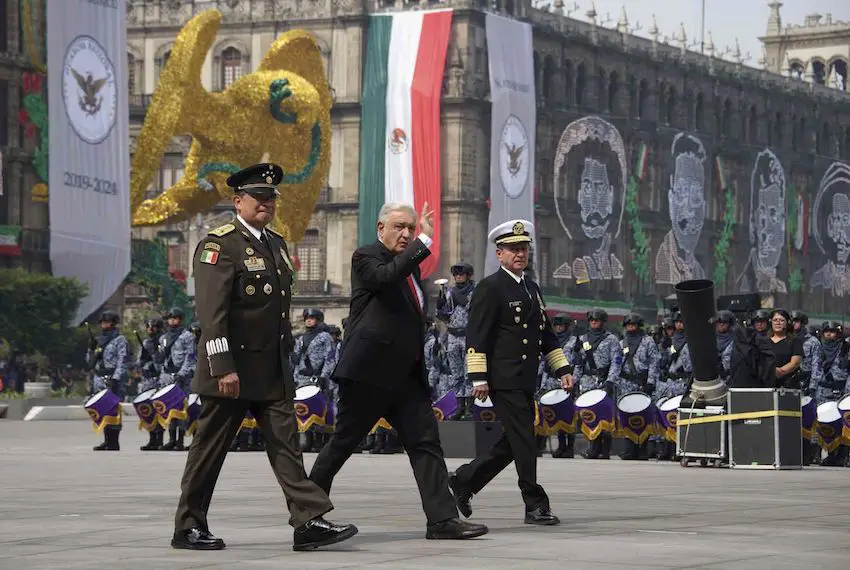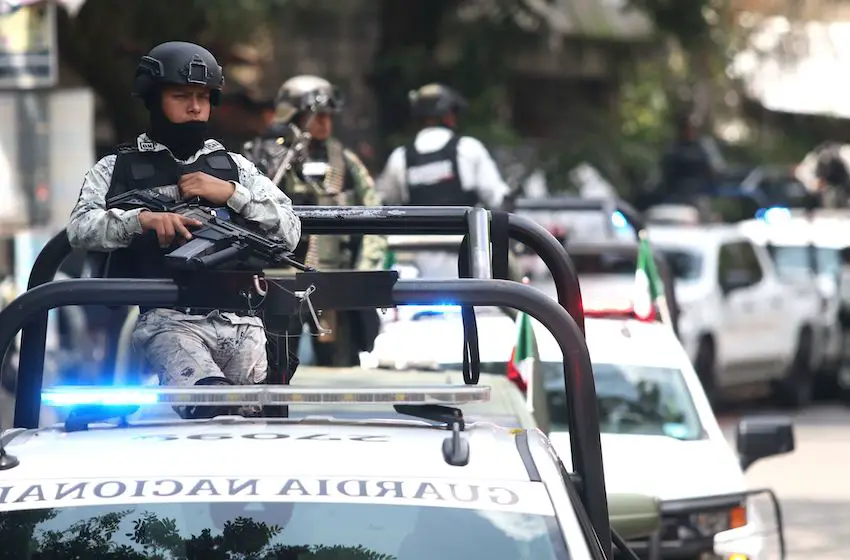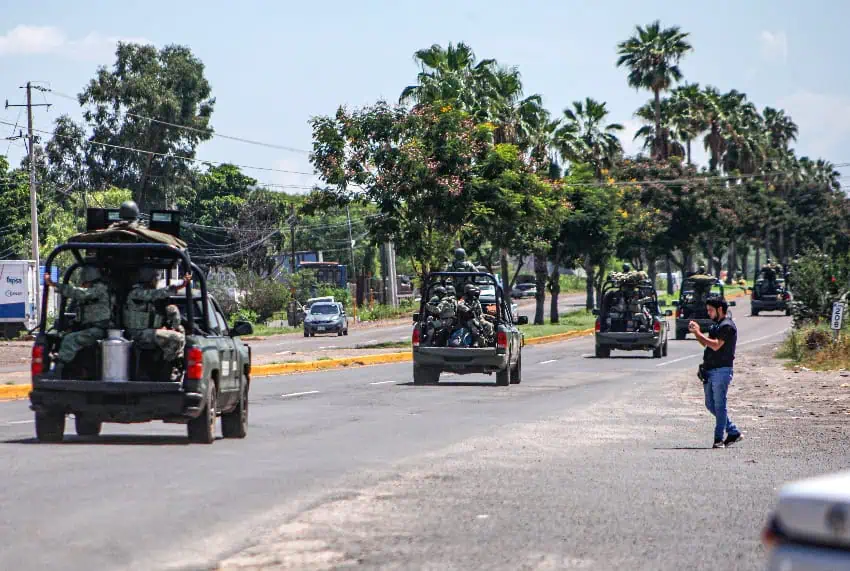Is President Sheinbaum’s new federal government forsaking the “not bullets” component of the so-called “hugs, not bullets” security strategy pursued by the administration of former president Andrés Manuel López Obrador (AMLO)?
In a report published on Thursday, the Associated Press said that “a string of bloody confrontations” during the first month of President Claudia Sheinbaum’s six-year term “suggests the government is quietly abandoning the ‘no bullets’ part of that strategy and is much more willing to use the full force of the military and the militarized National Guard.”
Before we look at the alleged evidence that the Sheinbaum administration is moving away from the security strategy championed by AMLO, let’s first take a step back.
What is (or was) the ‘Hugs, not bullets’ strategy?
In a nutshell, the “hugs, not bullets,” or “abrazos, no balazos,” strategy is an approach to public security in which addressing the root causes of crime through government social programs is favored over combating criminal groups with force.
The previous government poured huge amounts of money into social programs, including employment schemes that aim to provide work opportunities to disadvantaged young people who might otherwise be tempted to join the ranks of criminal groups.
In support of the “no bullets” aspect of the strategy, López Obrador directed federal security forces to avoid violent confrontations with cartels whenever possible, although clashes still occurred.

The previous president drew significant criticism in 2022 when he said that by avoiding confrontations, “We look after the members of the armed forces … but we also look after the members of the gangs.”
The Sheinbaum administration presented its national security strategy a month ago, and one of its four core tenets is attention to the root causes of crime, i.e. the “hugs” component of AMLO’s approach. The government is maintaining all existing social programs, and adding new ones, as part of its strategy to reduce crime.
What about the ‘not bullets’ part?
The “bloody confrontations” AP referred to in its report are the following:
- On Oct. 1 — the day Sheinbaum was sworn in — the Mexican Army opened fire on vehicles that attempted to evade military personnel carrying out patrols in Chiapas. The vehicles, which the army said were “like those that crime groups in the region use,” were transporting migrants, six of whom were killed and 10 of whom were injured.
- On Oct. 11 and 12, three citizens, including a nurse and an eight-year-old girl, were killed in the crossfire of shootouts in Nuevo Laredo between security forces and suspected criminals. One person was killed by soldiers and two by National Guard troops.
- Mexican soldiers killed 19 suspected members of the Sinaloa Cartel after they were attacked by more than 30 gunmen near Culiacán on Oct. 22. No soldiers were killed or wounded. AP reported that the killing of the 19 drug cartel suspects in “a lopsided encounter” in which soldiers “suffered not a scratch themselves … awakened memories of past human rights abuses, like a 2014 incident in which soldiers killed about a dozen cartel suspects after they had surrendered.”
- In late October in Guerrero, soldiers killed 17 cartel gunmen, most of whom were Guatemalan. No soldiers were killed in the confrontation, which occurred after the cartel gunmen killed two local police officers in the coastal municipality of Técpan de Galeana.
Does the use of force by federal security forces in the incidents outlined above provide evidence that the government is abandoning the “not bullets” part of AMLO’s security strategy?
“There are traces of a change in tone toward organized crime, but it’s too early to call,” Falko Ernst, a security analyst, told AP.
“It seems unlikely that the Sheinbaum administration would risk a politically inconvenient, steady stream of violent imagery by betting on wholesale balazos [bullets]-only strategy,” he said.

However, Ernst added that the government may be more willing to confront “the most overt and brazen displays of power” by criminal organizations.
David Saucedo, another security analyst, has a different view.
“The hugs not bullets strategy ended some time ago,” he told AP.
The Associated Press reported that Saucedo pointed to “an increased number of high-level drug arrests and extraditions of suspects” to support his claim.
“The U.S. government pressured Andrés Manuel López Obrador to resume the capture of high-level drug lords,” Saucedo said.
During the López Obrador administration, federal security forces did manage to finally capture Ovidio Guzmán, one of the sons of convicted drug trafficker Joaquín “El Chapo” Guzmán, after releasing him to avoid a bloodbath amid a violent Sinaloa Cartel response in 2019. However, they had no involvement in the arrest of the highest-level drug lord to be detained in recent years — Ismael “El Mayo” Zambada.
Presenting the government’s new security strategy last month, Security Minister Omar García Harfuch said the neutralization of “generators of violence and criminal networks” was an objective, but he didn’t say security forces were prepared to use a heavier hand to achieve it.
Instead, he emphasized the importance of other crime-fighting tools, such as intelligence.
What has Sheinbaum said about her government’s security strategy?
Although her government is perpetuating virtually all of AMLO’s policies as it seeks to build the “second story” of the so-called “fourth transformation” of Mexico, Sheinbaum “has studiously avoided using the ‘hugs, not bullets’ slogan popularized by her predecessor and mentor,” AP reported.
However, she has said on repeated occasions that her government won’t pursue the kind of militarized “war” against drug cartels that former president Felipe Calderón launched shortly after he took office in December 2006.
“Calderón’s war against narcos won’t return,” Sheinbaum said last month.
Those remarks appear to indicate that she doesn’t have any great appetite for increasing the use of force against criminal groups.

In addition, shortly before she was sworn in as president, Sheinbaum said that responding to the high levels of violence in Sinaloa with “firepower” would only trigger a “war” in the northern state, where rival factions of the Sinaloa Cartel are engaged in a battle that has claimed scores of lives in recent months.
After García outlined the national security strategy on Oct. 8, Sheinbaum declared that her government wasn’t seeking to carry out “extrajudicial executions,” and would use “prevention, intelligence and presence” of security forces to combat crime.
While she avoids using the “hugs, not bullets” slogan, it would appear unlikely that the president and commander in chief of Mexico’s armed forces would agree with claims that her government, in its first month in office, has shown it is prepared to use more force than its predecessor to combat the country’s notorious cartels.
A fuller picture of the government’s security strategy, and the extent to which it is prepared to use military and National Guard firepower to respond to Mexico’s many and varied security challenges, will only truly emerge in the months and years ahead.
With reports from AP
